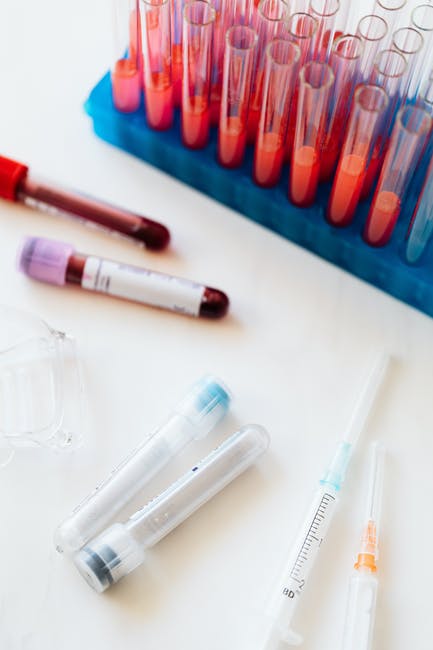What Do My Blood Test Results Mean?

It’s that time of year again.
Your doctor has requested blood work.
Whether or not you like needles, it’s the waiting for blood test results that really makes you nervous. The overwhelm continues when the chart arrives. Your doctor rattles through each biomarker and you’re sitting there wondering, ‘Am I healthy or not?’
There are so many data points in one small sample. Being in perfect health is a bit more nuanced than a yes or no answer.
Wouldn’t you have more peace of mind if you understood what your lab test results meant? If you could have a productive conversation with your doctor about your health?
Understanding what your results mean could make your trip to the doctor much less nerve-wracking. Read on to know what to look for on your next blood test results chart.
What Normal Means
Interpretation of blood test results can vary across the medical field. There are defined ranges for what experts consider normal for some biomarkers (e.g. cholesterol). Blood samples from healthy control subjects play a role in defining other data ranges.
Pathology labs combine defined ranges from the National Institutes of Health and ranges established by a control group of healthy humans to set their standards.
When a result falls outside of the normal range, there is no need for immediate panic. What is just outside of normal at one lab, could be considered fine at a totally different lab.
Your age, sex, race, and even time of day can influence how your results compare to the ranges established by a particular lab. Discussing these factors with your doctor will help you understand the context behind your results.
Your ‘normal’ may be different from the lab’s normal and that’s ok. Normal does not necessarily mean ideal. It is largely dependent on the control population used as a reference point.
Key Biomarkers
There are many biomarkers that can be tested in a blood exam. The most common are listed below:
Glucose
Part of the basic metabolic panel of biomarkers, glucose measures the body’s regulation of blood sugar. This factor can help a doctor determine if you’re at risk of diabetes.
Electrolytes & Kidney Function
Another common indicator within the basic metabolic panel is electrolytes. Electrolytes paint of picture of pH levels in the body.
Measurements in this group focus on the relationship between sodium and chloride within the body. High levels of one can affect the levels of the other. Potassium levels are also included in this category.
Irregular levels of any three could indicate issues with kidney function. They also tell signs of dehydration or a diet high in salt.
Kidney function is also assessed via measurements of creatine, protein, and blood urea nitrogen.
Liver Function
Liver function is measured primarily through liver enzymes (specifically ALT, AST, and ALP), and total bilirubin. High levels of either of these are possible signs of improper liver function.
Lipids
These tests examine the fatty content within the blood. Markers in this category help doctors measure factors that could influence heart health, like cholesterol.
Complete Blood Count (CBC)
This panel is a comprehensive measure of the blood cells in your body. This test measures red and white cell volume within the bloodstream. It also accounts for different proteins within the blood, like hemoglobin.
CBC is one of the most common blood tests. It can help doctors determine if the body is fighting off foreign pathogens. It also is a key factor in diagnosing anemia.
This comprehensive panel does an amazing job of rooting out any issues before they manifest as physical problems within the body. So when CBC levels do not fall within the normal range, a doctor will often request that you take another test.
Sexually Transmitted Diseases
Your doctor may suggest including STD results in your test as well. The meaning behind these tests is more straightforward than the others since there isn’t a range to compare against. Either the subject has the tested disease or they don’t.
Test Interpretation Aids
Some sites allow you to enter your blood test results online. You can use tools like this to see how your results compare with the normal range.
Of course, any findings should be discussed with your doctor as they will have the best understanding of your health history.
Blood Test Results Over Time
No one blood test is conclusive. Each test you take is one data point on your health journey. Your results may fluctuate over time due to age, medication, fasting time, and a variety of other factors.
Consistent testing paints a much clear picture of your health. And over time, you can work with your doctor to create a specific game plan to keep your levels in check. Controlling for external factors, like medications and hours spent fasting, will ensure your results remain accurate over the years.
Studies have also shown that regular blood tests can highlight health risks earlier than some screening exams.
Make the Most of Your Blood Test
Understanding what your lab test results mean allows you to have a productive conversation with your doctor. If you know what these biomarkers mean, you’ll have a better knowledge of how to maintain them.
You’ll make better choices with diet, physical activity, and wellness.
And overall, you’ll become a healthier person.
If you found this quite interesting, read on to discover more about blood test results. And if you’d like to learn more about the phlebotomy services we provide, leave us a comment below!
